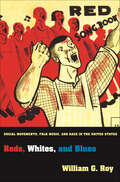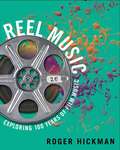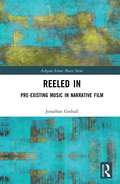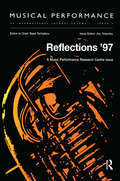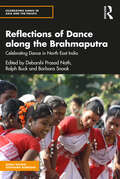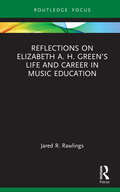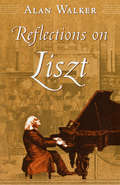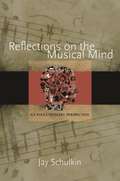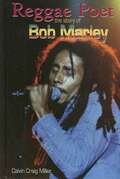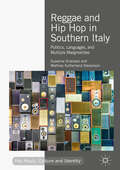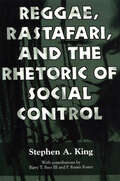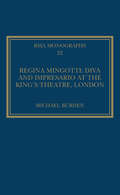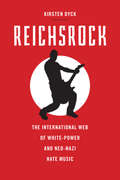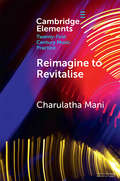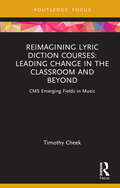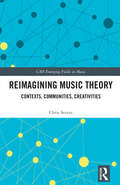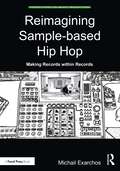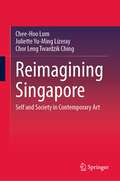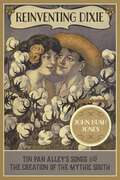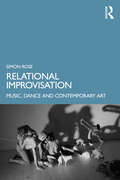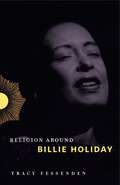- Table View
- List View
Reds, Whites, and Blues: Social Movements, Folk Music, and Race in the United States (Princeton Studies in Cultural Sociology #45)
by William G. RoyMusic, and folk music in particular, is often embraced as a form of political expression, a vehicle for bridging or reinforcing social boundaries, and a valuable tool for movements reconfiguring the social landscape. Reds, Whites, and Blues examines the political force of folk music, not through the meaning of its lyrics, but through the concrete social activities that make up movements. Drawing from rich archival material, William Roy shows that the People's Songs movement of the 1930s and 40s, and the Civil Rights Movement of the 1950s and 60s implemented folk music's social relationships--specifically between those who sang and those who listened--in different ways, achieving different outcomes. Roy explores how the People's Songsters envisioned uniting people in song, but made little headway beyond leftist activists. In contrast, the Civil Rights Movement successfully integrated music into collective action, and used music on the picket lines, at sit-ins, on freedom rides, and in jails. Roy considers how the movement's Freedom Songs never gained commercial success, yet contributed to the wider achievements of the Civil Rights struggle. Roy also traces the history of folk music, revealing the complex debates surrounding who or what qualified as "folk" and how the music's status as racially inclusive was not always a given. Examining folk music's galvanizing and unifying power, Reds, Whites, and Blues casts new light on the relationship between cultural forms and social activity.
Reel Music: Exploring 100 Years of Film Music
by Roger HickmanReel Music, revised for a new generation of movie lovers, tells the story of film music through iconic scenes. The Second Edition features more in-depth exploration of international films--from classics like Seven Samurai to more recent works like Run Lola Run--as well as new suggestions for activities and classroom discussion, and even more Viewer Guides, which show how film music functions moment-by-moment.
Reeled In: Pre-existing Music in Narrative Film (Ashgate Screen Music Series)
by Jonathan GodsallHow and why is pre-existing music used in films? What effects can its use have on films and their audiences? And what lasting impact can appropriation have on the music? Reeled In is a comprehensive exploration of these questions, considering the cinematic quotation of Beethoven symphonies, Beatles songs, and Herrmann scores alike in films ranging from the early sound era to the present day, and in every role from ‘main title theme’ to ‘music playing in bar’. Incorporating a discussion of such factors as copyright and commerce alongside examination of texts and their effects, this broad study is a significant contribution to the scholarship on music in screen media, demonstrating that pre-existing music possesses unique attributes that can affect both how filmmakers construct their works and how audiences receive them, to an extent regardless of the music’s style, genre, and so on. This book also situates the reception of music by film, and by audiences experiencing that music through film, as significant processes within present-day culture, while more generally providing an illuminating case study of the kinds of borrowings, adaptations, and reinventions that characterize much of today’s art and entertainment.
Reflections '97: A special issue of the journal Musical Performance
by Jon TolanskyReflections, the Yearbook of the Music Performance Research Centre, is published as an issue within the international journal Musical Performance series. It features articles written by musicians and interviews with performers. Reflections '97 includes an interview with the tenor Jon Vickers and a personal memoir of the conductor Carlos Kleiber.
Reflections from the Keyboard: The World of the Concert Pianist
by David DubalInterviews with 35 noted pianists, with selected discography
Reflections of Dance along the Brahmaputra: Celebrating Dance in North East India (Celebrating Dance in Asia and the Pacific)
by Debarshi Prasad Nath, Ralph Buck, and Barbara SnookThis volume brings a critical lens to dance and culture within North East India. Through case studies, first-hand accounts, and interviews, it explores unique folk dances of Indigenous communities of North East India that reflect diverse journeys, lifestyles, and connections within their ethnic groups, marking almost every ritual and festival. Dance for people of North East India, as elsewhere, is also a way of declaring, establishing, celebrating, and asserting humans' relationship with nature. The book draws attention to the origins and special circumstances of dances from North East India. It discusses a range of important folk-dance forms alongside classical dance forms in North East India, with a focus on Sattriya dance. The chapters examine how these dance forms play an important role in the region’s socio-cultural, economic, and political life, intertwining religion and the arts through music, dance, and drama. Further, they also explore how folk dance cultures in North East India have never been relegated to the background, never considered secondary, aesthetically, or otherwise, but have become expressions of political and cultural identity. An evocative work, this volume will be of interest to students and researchers of pedagogy, choreography, community dance practice, theatre and performance studies, social and cultural studies, aesthetics, interdisciplinary arts, and more. It will be an invaluable resource for artists and practitioners working in dance schools and communities.
Reflections on Elizabeth A. H. Green’s Life and Career in Music Education
by Jared R. RawlingsAn engaging integration of scholarship and storytelling, Reflections on Elizabeth A. H. Green’s Life and Career in Music Education details the life and career of a pioneering figure in the field of instrumental music teacher education, who was one of the first to document a curriculum for teaching conducting and stringed instruments. Featuring interviews with Green’s former students, faculty colleagues, and close friends, this account combines reflections and memories with Green’s conducting techniques and teachings. Reflections on Elizabeth A. H. Green’s Life and Career in Music Education uncovers pedagogical insights not available in the late educator’s published texts, focusing on ways to assist instructors in new and different ways to manage and direct large ensembles and build confidence in undergraduate music majors. Through the exploration of an extraordinary educator’s life, it offers new insights into both the history of music education and present-day pedagogy for string instruments and conducting.
Reflections on Liszt
by Alan WalkerIn a series of lively essays that tell us much not only about the phenomenon that was Franz Liszt but also about the musical and cultural life of nineteenth-century Europe, Alan Walker muses on aspects of Liszt's life and work that he was unable to explore in his acclaimed three-volume biography of the great composer and pianist. Topics include Liszt's contributions to the Lied, the lifelong impact of his encounter with Beethoven, his influence on students who became famous in their own right, his accomplishments in transcribing and editing the works of other composers, and his innovative piano technique. One chapter is devoted to the Sonata in B Minor, perhaps Liszt's single most celebrated composition.Walker draws heavily on Liszt's astonishingly large personal correspondence with other composers, critics, pianists, and prominent public figures. All the essays reveal Walker's broad and deep knowledge of Liszt and Romantic music generally and, in some cases, his impatience with contemporary performance practice.
Reflections on the Musical Mind: An Evolutionary Perspective
by Jay SchulkinWhat's so special about music? We experience it internally, yet at the same time it is highly social. Music engages our cognitive/affective and sensory systems. We use music to communicate with one another--and even with other species--the things that we cannot express through language. Music is both ancient and ever evolving. Without music, our world is missing something essential.In Reflections on the Musical Mind, Jay Schulkin offers a social and behavioral neuroscientific explanation of why music matters. His aim is not to provide a grand, unifying theory. Instead, the book guides the reader through the relevant scientific evidence that links neuroscience, music, and meaning. Schulkin considers how music evolved in humans and birds, how music is experienced in relation to aesthetics and mathematics, the role of memory in musical expression, the role of music in child and social development, and the embodied experience of music through dance. He concludes with reflections on music and well-being. Reflections on the Musical Mind is a unique and valuable tour through the current research on the neuroscience of music.
Reflections: Performers/Audiences/Recordings (Musical Performance Ser. #Vols. 1, Pts. 1.)
by Basil Tschaikov Jon TolanskyFirst Published in 1997. Routledge is an imprint of Taylor & Francis, an informa company.
Reggae Poet: The Story of Bob Marley
by Calvin Craig MillerBefore he was the face of reggae music and the most prominent practitioner of Rastafarian religion, Bob Marley was a little boy called Nesta, growing up in the tiny Jamaican village of Nine Miles. The only son of a Jamaican farmer's daughter and an aging British government official, the young boy was rejected by both white and black society, and tormented by gangs in the poor neighborhoods of Trench Town.
Reggae and Hip Hop in Southern Italy: Politics, Languages, and Multiple Marginalities (Pop Music, Culture and Identity)
by Susanna Scarparo Mathias Sutherland StevensonThis book explores the significance of reggae and hip hop in Southern Italy from the beginning of the 1980s to the present. Focusing on groups and solo artists located predominantly in the Southern Italian regions of Apulia and Sardinia, it examines the production and distribution of their music, lyrics and video clips. To this end, Reggae and Hip Hop in Southern Italy emphasizes the linguistic aspects of cultural marginalization as well as marginalities linked to geographical location, gender, and to social and political identification. The authors put forward three key arguments, namely: that the Southern Italian transcultural and multilingual musical productions defy the cultural stereotype of the South; that the musicians discussed are creating new alliances and transcultural exchanges that engage critically with the challenges and opportunities offered by globalization; and that these musical productions represent one of Italy’s most significant forms of creative political expression since the 1970s. Reggae and Hip Hop in Southern Italy brings to light the distinctive characteristics of Italy’s independent and marginal musical contexts of reggae and reggae-inflected hip hop. It will serve as an invaluable resource for academics and students of Italian cultural studies, global studies, and the politics of non-hegemonic cultural production. It also provides an engaging reference for those with an interest in southern Italy, Apulia, Sardinia, the southern question and independent and popular music more generally.
Reggae, Rastafari, and the Rhetoric of Social Control
by Stephen A. KingWho changed Bob Marley’s famous peace-and-love anthem into “Come to Jamaica and feel all right?” When did the Rastafarian fighting white colonial power become the smiling Rastaman spreading beach towels for American tourists? Drawing on research in social movement theory and protest music, Reggae, Rastafari, and the Rhetoric of Social Control traces the history and rise of reggae and the story of how an island nation commandeered the music to fashion an image and entice tourists. Visitors to Jamaica are often unaware that reggae was a revolutionary music rooted in the suffering of Jamaica’s poor. Rastafarians were once a target of police harassment and public condemnation. Now the music is a marketing tool, and the Rastafarians are no longer a “violent counterculture” but an important symbol of Jamaica’s new cultural heritage. This book attempts to explain how the Jamaican establishment’s strategies of social control influenced the evolutionary direction of both the music and the Rastafarian movement. From 1959 to 1971, Jamaica’s popular music became identified with the Rastafarians, a social movement that gave voice to the country’s poor black communities. In response to this challenge, the Jamaican government banned politically controversial reggae songs from the airwaves and jailed or deported Rastafarian leaders. Yet when reggae became internationally popular in the 1970s, divisions among Rastafarians grew wider, spawning a number of pseudo-Rastafarians who embraced only the external symbolism of this worldwide religion. Exploiting this opportunity, Jamaica’s new Prime Minister, Michael Manley, brought Rastafarian political imagery and themes into the mainstream. Eventually, reggae and Rastafari evolved into Jamaica’s chief cultural commodities and tourist attractions.
Regina Mingotti: Diva And Impresario At The King's Theatre, London (Royal Musical Association Monographs)
by Michael BurdenRegina Mingotti was the first female impresario to run London's opera house. Born in Naples in 1722, she was the daughter of an Austrian diplomat, and had worked at Dresden under Hasse from 1747. Mingotti left Germany in 1752, and travelled to Madrid to sing at the Spanish court, where the opera was directed by the great castrato, Farinelli. It is not known quite how Francesco Vanneschi, the opera promoter, came to hire Mingotti, but in 1754 (travelling to England via Paris), she was announced as being engaged for the opera in London 'having been admired at Naples and other parts of Italy, by all the Connoisseurs, as much for the elegance of her voice as that of her features'. Michael Burden offers the first considered survey of Mingotti‘s London years, including material on Mingotti's publication activities, and the identification of the characters in the key satirical print 'The Idol'. Burden makes a significant contribution to the knowledge and understanding of eighteenth-century singers' careers and status, and discusses the management, the finance, the choice of repertory, and the pasticcio practice at The King's Theatre, Haymarket during the middle of the eighteenth century. Burden also argues that Mingotti‘s years with Farinelli influenced her understanding of drama, fed her appreciation of Metastasio, and were partly responsible for London labelling her a 'female Garrick'. The book includes the important publication of the complete texts of both of Mingotti's Appeals to the Publick, accounts of the squabble between Mingotti and Vanneschi, which shed light on the role a singer could play in the replacement of arias.
Reichsrock: The International Web of White-Power and Neo-Nazi Hate Music
by Kirsten DyckFrom rap to folk to punk, music has often sought to shape its listeners' political views, uniting them as a global community and inspiring them to take action. Yet the rallying potential of music can also be harnessed for sinister ends. As this groundbreaking new book reveals, white-power music has served as a key recruiting tool for neo-Nazi and racist hate groups worldwide. Reichsrock shines a light on the international white-power music industry, the fandoms it has spawned, and the virulently racist beliefs it perpetuates. Kirsten Dyck not only investigates how white-power bands and their fans have used the internet to spread their message globally, but also considers how distinctly local white-power scenes have emerged in Western Europe, Eastern Europe, Latin America, the United States, and many other sites. While exploring how white-power bands draw from a common well of nationalist, racist, and neo-Nazi ideologies, the book thus also illuminates how white-power musicians adapt their music to different locations, many of which have their own terms for defining whiteness and racial otherness. Closely tracking the online presence of white-power musicians and their fans, Dyck analyzes the virtual forums and media they use to articulate their hateful rhetoric. This book also demonstrates how this fandom has sparked spectacular violence in the real world, from bombings to mass shootings. Reichsrock thus sounds an urgent message about a global menace.
Reimagine to Revitalise: New Approaches to Performance Practices Across Cultures (Elements in Twenty-First Century Music Practice)
by Charulatha ManiReimagining Lyric Diction Courses: CMS Emerging Fields in Music (CMS Emerging Fields in Music)
by Timothy CheekDrawing on 30 years of teaching experience, author Timothy Cheek demonstrates how a university lyric diction class—traditionally specialized and Eurocentric—can become transformative, through engaging students with other languages and cultures, and promoting diversity, equity, inclusivity, and antiracism. Raising new possibilities for traditional lyric diction pedagogy, this book explores how to provide students with experiences that speed their growth, help them to see the big picture, spark their curiosity, clarify and expand their digital resources and skills, and set them on a path of international collaboration. Arguing against compartmentalization in voice curricula, and exploring opportunities for creativity, the author provides a guide to new approaches that will aid schools’ decisions about diction curricula in the challenging but promising era of 21st-century pedagogy. Voice faculty, diction instructors, curriculum committees, graduate students in related fields, and music school administrators should all find this book insightful and thought-provoking as it goes to the heart of issues critical to the long-term development of today’s voice students.
Reimagining Music Theory: Contexts, Communities, Creativities (CMS Emerging Fields in Music)
by Chris StoverReimagining Music Theory: Contexts, Communities, Creativities invites instructors to rethink how we teach music theory, challenging the traditional, classical canon-based pedagogy and offering new and alternative approaches.The study and teaching of music theory are at a crucial and invigorating crossroads, as conversations are being held about contesting canons, transforming pedagogical practices, and finding meaningful ways to make the field inclusive and diverse in repertoire, methods, and student experiences. This book aims to reimagine music theory as an explicitly and radically dialogic, creative, nimble transdisciplinary space where thinking and acting can be both deep and broad, where pluralities of knowledge systems and ways of doing and being can interact and mutually inform one another, and where teachers learn from students as much as the other way around. Rethinking what counts as music fundamentals, opening music theory to a plurality of global practices, and considering music theory as a creative and community practice are all addressed.Incorporating interviews with scholar-teachers at the forefront of innovative music theory pedagogy throughout, the book offers music theory professors and instructors frameworks for enacting meaningful change in the music theory classroom.
Reimagining Sample-based Hip Hop: Making Records within Records (Perspectives on Music Production)
by Michail ExarchosReimagining Sample-based Hip Hop: Making Records within Records presents the poetics of hip-hop record production and the significance of sample material in record making, providing analysis of key releases in hip-hop discography and interviews with experts from the world of Hip Hop and beyond. Beginning with the history of hip-hop music making, this book guides the reader through the alternative techniques deployed by beat-makers to avoid the use of copyrighted samples and concludes with a consideration of the future of Hip Hop, alongside a companion album that has been created using findings from this research. Challenging previous theoretical understandings about Hip Hop, the author focuses on deconstructing sonic phenomena using his hands-on engineering expertise and in-depth musicological knowledge about record production. With a significant emphasis on both practice and theory, Reimagining Sample-based Hip Hop will be of interest to advanced undergraduates, postgraduates, and researchers working in audio engineering, music production, hip-hop studies, and musicology.
Reimagining Singapore: Self and Society in Contemporary Art
by Chee-Hoo Lum Juliette Yu-Ming Lizeray Chor Leng Twardzik ChingThis book approaches the subject of contemporary art by exploring the social embeddedness and identities of Singaporean artists. Linking artistic processes and production to both personal worlds and wider issues, the book examines how artists negotiate their relationships between self and society and between artistic freedom and social responsibility. It is based on original research into the discourses and artistic practices of local artists, with a special focus on emerging artists and artists whose work and perspectives engage with questions of identity. Reimagining contemporary Singapore and their place within it, artists are asserting their multiple and heterogeneous self-identities and contesting hegemonic norms and notions, as they negotiate and adapt to the world around them. This book is relevant to students and researchers in the fields of cultural studies, media studies, art, sociology of art, arts education, and race and ethnicity studies.
Reinventing Dixie: Tin Pan Alley's Songs and the Creation of the Mythic South
by John Bush JonesTin Pan Alley, once New York City's songwriting and recording mecca, issued more than a thousand songs about the American South in the first half of the twentieth century. In Reinventing Dixie, John Bush Jones explores the broad impact of these songs in creating and disseminating the imaginary view of the South as a land of southern belles, gallant gentlemen, and racial harmony.In profiles of Tin Pan Alley's lyricists and composers, Jones explains how a group of undereducated and untraveled writers-the vast majority of whom were urban northerners or European immigrants- constructed the specific and detailed images of the South used in their song lyrics. In the process of evaluating the origins of Tin Pan Alley's songbook, Jones analyzes these songwriters' attitudes about North-South reconciliation, ideals of honor and hospitality, and the recurring theme of the yearning for home. Though a few of the songs employed parody or satire to undercut the vision of a peaceful, romantic South, the majority ignored the realities of racism and poverty in the region.By the end of Tin Pan Alley's era of cultural prominence in the mid-twentieth century, Jones contends that the work of its writers had cemented the "moonlight and magnolias" myth in the minds of millions of Americans. Reinventing Dixie sheds light on the role of songwriters in forming an idyllic vision of the South that continues to influence the American imagination.
Relational Improvisation: Music, Dance and Contemporary Art
by Simon RoseRelational Improvisation explores the creative exchanges that occur between artistic disciplines through the practice of improvisation in performance. Building upon the growing research into improvisation, the book explores contemporary transdisciplinary collaborations between improvised music and other fields including dance and visual arts, offering insights from a wide range of practitioners. Author Simon Rose takes a ground-up approach that places value on lived experience and reflects the value of collaboration. Mirroring improvisation’s relationality, chapters are co-authored by musicians, dancers and visual artists from diverse backgrounds who are engaged in active artistic collaborations with the author.The relational approach allows for the inclusion of improvisation’s scope and many levels. Showcasing a range of different voices, the chapters address topics in artistic improvisation including cybernetics, interspecies work, working with light, phenomenology, sympoiesis and identity, and utilise a range of approaches including autoethnography and philosophical analysis. Considering the relationships of improvisation to emotion, space, embodiment and philosophy, this book shows how improvisation, collaboration and transdisciplinary artistic practices combine to generate new creative possibilities. It provides vital insights for practicing artists, arts researchers, philosophy and pedagogy and all those studying improvisation and collaborative creativity in contemporary music, dance and visual arts.
Relevance and Marginalisation in Scandinavian and European Performing Arts 1770–1860: Questioning Canons
by Randi Margrete SelvikRelevance and Marginalisation in Scandinavian and European Performing Arts 1770–1860: Questioning Canons reveals how various cultural processes have influenced what has been included, and what has been marginalised from canons of European music, dance, and theatre around the turn of the nineteenth century and the following decades. This collection of essays includes discussion of the piano repertory for young ladies in England; canonisation of the French minuet; marginalisation of the popular German dramatist Kotzebue from the dramatic canon; dance repertory and social life in Christiania (Oslo); informal cultural activities in Trondheim; repertory of Norwegian musical clocks; female itinerant performers in the Nordic sphere; preconditions, dissemination, and popularity of equestrian drama; marginalisation and amateur staging of a Singspiel by the renowned Danish playwright Oehlenschläger, also with perspectives on the music and its composers; and the perceived relevance of Henrik Ibsen’s staged theatre repertory and early dramas. By questioning established notions about canon, marginalisation, and relevance within the performing arts in the period 1770–1860, this book asserts itself as an intriguing text both to the culturally interested public and to scholars and students of musicology, dance research, and theatre studies.
Religion Around Billie Holiday (Religion Around #3)
by Tracy FessendenSoulful jazz singer Billie Holiday is remembered today for her unique sound, troubled personal history, and a catalogue that includes such resonant songs as "Strange Fruit" and "God Bless the Child." Holiday and her music were also strongly shaped by religion, often in surprising ways. Religion Around Billie Holiday examines the spiritual and religious forces that left their mark on the performer during her short but influential life.Mixing elements of biography with the history of race and American music, Tracy Fessenden explores the multiple religious influences on Holiday’s life and sound, including her time spent as a child in a Baltimore convent, the echoes of black Southern churches in the blues she encountered in brothels, the secular riffs on ancestral faith in the poetry of the Harlem Renaissance, and the Jewish songwriting culture of Tin Pan Alley. Fessenden looks at the vernacular devotions scholars call lived religion—the Catholicism of the streets, the Jewishness of the stage, the Pentecostalism of the roadhouse or the concert arena—alongside more formal religious articulations in institutions, doctrine, and ritual performance.Insightful and compelling, Fessenden’s study brings unexpected materials and archival voices to bear on the shaping of Billie Holiday’s exquisite craft and indelible persona. Religion Around Billie Holiday illuminates the power and durability of religion in the making of an American musical icon.
Religion Around Billie Holiday (Religion Around)
by Tracy FessendenSoulful jazz singer Billie Holiday is remembered today for her unique sound, troubled personal history, and a catalogue that includes such resonant songs as “Strange Fruit” and “God Bless the Child.” Holiday and her music were also strongly shaped by religion, often in surprising ways. Religion Around Billie Holiday examines the spiritual and religious forces that left their mark on the performer during her short but influential life.Mixing elements of biography with the history of race and American music, Tracy Fessenden explores the multiple religious influences on Holiday’s life and sound, including her time spent as a child in a Baltimore convent, the echoes of black Southern churches in the blues she encountered in brothels, the secular riffs on ancestral faith in the poetry of the Harlem Renaissance, and the Jewish songwriting culture of Tin Pan Alley. Fessenden looks at the vernacular devotions scholars call lived religion—the Catholicism of the streets, the Jewishness of the stage, the Pentecostalism of the roadhouse or the concert arena—alongside more formal religious articulations in institutions, doctrine, and ritual performance.Insightful and compelling, Fessenden’s study brings unexpected materials and archival voices to bear on the shaping of Billie Holiday’s exquisite craft and indelible persona. Religion Around Billie Holiday illuminates the power and durability of religion in the making of an American musical icon.
